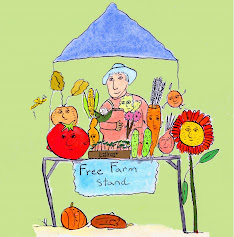This past Sunday was the first Free Farm Stand we have had with no rain in several weeks and the park was filled with people enjoying the sun. We had so much food (more than I could fit on my wagon), so I had to make two trips moving it to the park from my house. By 2:30pm we had given out almost all the produce and bread, and by the time we were all packed up and ready to leave there was absolutely nothing left (a couple came and took what little there was, and they seemed to really appreciate the small bag of greens and the few small pumpkins we had left).
The day was extra busy and crowded with the garden work day happening at the same time. Kids were planting strawberries and adults were weeding and distributing mulch throughout the garden.
On Friday we had a great turnout for our workday at 18th and Rhode Island garden. I was a bit concerned that we were not going to move all the mulch we had gotten from Bay View Green Waste Management (20 cubic yards!). I was wrong to worry because it was all spread out at the end of the day. Here is how we sheet mulched the entire rocky hill: We had 9 energetic volunteers who showed up. They moved two tons of cardboard and spread it over the remaining bare earth where ivy, oxalis, and fennel grew. The cardboard was watered down. There was a pile of mushroom blocks from Far West Fungi in the garden when I arrived. The blocks were crumbled up and then spread over the cardboard and mulch. The mushrooms will help break down the mulch. We also had some aged horse manure that was spread at the same time over the cardboard. Then the mulch, ground up wood chips and brush that has been ground up really fine, was dumped on top of the cardboard.
This Friday we will be ready to build and plant potato towers and some sunchokes. We also have more strawberries to plant and carrots.
Tuesday we were rained out and I didn't get to garden with the Jamestown kids in the Secret Garden. On Saturday there was a small cleanup day there and we got rid of a lot of garbage and took down the play structure to make room for more planting. This Tuesday we will plant a lettuce lawn and some kale and other greens, and maybe another potato tower.
My big goal this week is to pot up all the tomato seedlings we have started and hopefully plant more seeds. I love growing seedlings. We have the goal of helping our neighbors start their own gardens if they have room and seeing more food being grown everywhere there is sunny space to plant. We are promoting the idea of sharing the surplus produce and eventually having our neighborhood being a true Pasture of Plenty as Woody Guthrie wrote in a song. A neighborhood that is known for the food it grows, isn't that a trippy idea? The famous Mission grown tomato or apricot… Propagating lots of seedlings (and other edible plants) and distributing them for free is part of the dream. Recently someone sent me a link for a interesting project in Portland http://www.eatyouryard.com/services/plant-starts/ that has a similar vision, though they charge for their services, a CSA growing starts rather than food. What we need are some people to help me grow starts to give away at the Free Farm Stand and to neighbors that are planting gardens. I can teach people the basics of planting and growing starts, and what I need are people with some sunny space to put a cold frame or shelf (or greenhouse) and some motherly care to grow the starts until they are ready to give out.
Along this same train of thought, I recently rejoined the Seed Savers Exchange (http://www.seedsavers.org) and their newest catalog arrived in the mail. I now have access to seeds of thousands of heirloom vegetables. I am excited just reading about all the different kales we can try growing or tomatoes and then we can save the seed for the ones we like. I also got a copy of a book that Kevin highly recommended called Cornucopia II: A Source Book of Edible Plants by Stephen Facciola. It says in the introduction of this book that “There are approximately fifteen thousand plants recorded in literature as having been used as food by man. One hundred and fifty or more of these have been cultivated on a commercial scale…Yet today, most of the world is fed by approximately twenty crops…” The author is making the point that we should be utilize more of the food crops available. Kevin told me the other day he is excited because he finally found a source for a perennial broccoli he has been looking for forever and he wants to share some seed with me when he gets it. This is really what makes growing our own food so much fun and valuable. And it all starts with some form of propagation, planting seeds and growing starts or grafting or rooting cuttings.


No comments:
Post a Comment